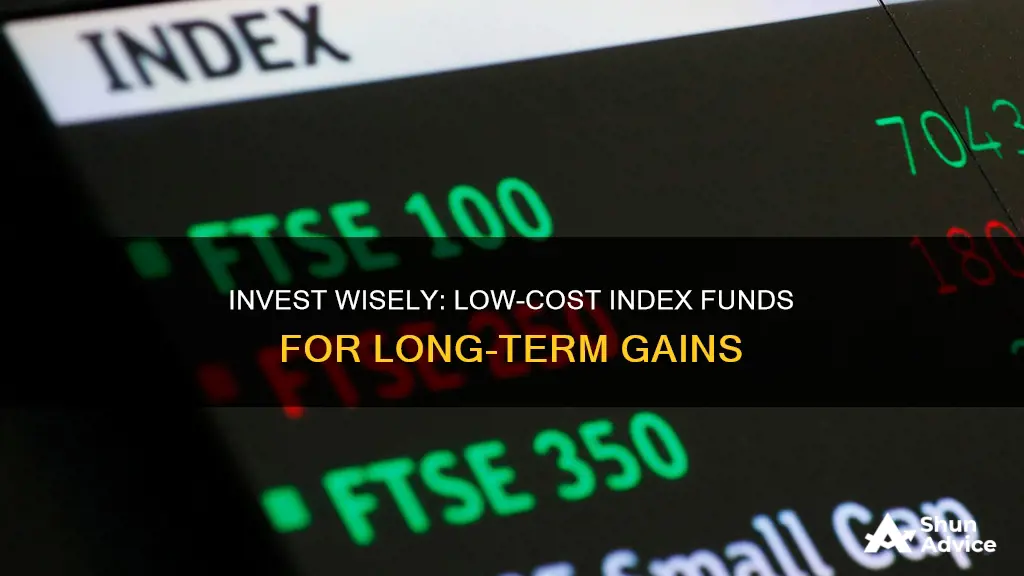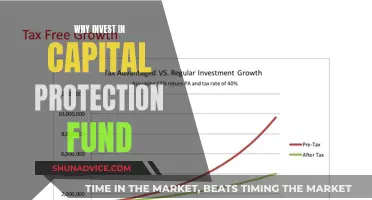
Index funds are a great way to invest in the stock market, especially for beginners. They are a low-cost, easy way to build wealth and are recommended by legendary investor Warren Buffett.
Index funds are a type of investment fund that tracks a specific collection of assets called an index. The index can include stocks, bonds and other assets, and the fund does not actively invest in the market but tries to match the performance of the index by holding the same assets in the same proportions. This passive investment strategy reduces risk compared to investing in individual stocks and minimises the time and money spent investing.
When choosing an index fund to invest in, it is important to look at the fund's long-term returns and the cost to own the fund. Index funds typically have lower expense ratios because they are passively managed, so it is important to find a fund with a low expense ratio.
Index funds can be bought and sold as either an exchange-traded fund (ETF) or a mutual fund. ETFs are traded on exchanges like individual stocks, while mutual funds pool money to buy a portfolio of stocks or bonds and are bought and sold directly from the fund company.
Some popular index funds include the Vanguard S&P 500 ETF, the Fidelity 500 Index Fund, and the iShares Core S&P 500 ETF. These funds have low expense ratios and track the S&P 500, which includes 500 of the largest publicly traded American companies.
Index funds offer investors a simple, cost-effective, and diversified way to invest in the stock market, making them a great choice for those looking to minimise risk and costs.
| Characteristics | Values |
|---|---|
| Type of fund | Exchange-traded fund (ETF) or mutual fund |
| Investment strategy | Passive |
| Investment risk | Lower than actively managed funds |
| Investment research | Minimal |
| Investment diversification | High |
| Investment returns | Comparable to the market or benchmark index |
| Investment fees | Low expense ratios |
| Investment taxes | Tax-efficient |
| Investment minimum | Varies by fund and broker |
| Investment account | Brokerage account, individual retirement account (IRA) or Roth IRA |
What You'll Learn

Understand the benefits of low-cost index funds
Low-cost index funds are a great way to invest in the stock market while keeping fees to a minimum. They are a type of exchange-traded fund (ETF) or mutual fund that tracks a specific collection of assets called an index. The index can include stocks, bonds, and other assets such as commodities like gold.
Broad Diversification
Investing in index funds instantly diversifies your portfolio, reducing the likelihood of losing money. Index funds hold a variety of stocks, so even if some perform poorly, others may balance it out with strong performance.
Low Costs
Index funds have lower costs than other types of funds. They have lower management fees because they are passively managed, meaning they simply track an index by buying and holding stocks, rather than actively trading. This passive management also results in lower turnover ratios, reducing capital gains taxes.
Attractive Returns
Index funds tend to generate attractive returns over time, often outperforming other types of funds that are actively managed. This is because index funds aim to match the performance of the market or a specific index, and the overall stock market generally increases in value over time.
Tax Efficiency
Index funds are tax-efficient because they don't generate as much capital gains tax liability as actively managed funds. This is due to their low turnover ratios, as fund managers aren't constantly buying and selling stocks.
Minimal Investment Research
With index funds, you can rely on the fund manager to match the performance of the underlying index, so you don't need to spend time researching individual stocks.
Managed Investment Risk
The diversification of index funds means you are less likely to suffer significant losses if something negative happens to a particular company or sector in the index.
Wide Range of Options
There are hundreds of indexes to choose from when investing in index funds, from broad indexes like the S&P 500 to specific sectors, countries, or types of stocks.
Building Your Portfolio Over Time
Index funds allow you to be a passive investor. You can invest regularly, ignoring short-term fluctuations, confident that you will benefit from the market's long-term growth.
Trust Funds in the Philippines: A Guide to Investing
You may want to see also

Know the risks of low-cost index funds
Low-cost index funds are an excellent way to get exposure to the stock market without excessive fees, but it's important to be aware of the risks involved. Here are some key points to consider:
- Volatility and Downside Risk: Index funds track their respective markets, so they can be volatile, especially during economic downturns or stock market crashes. In a bear market, your index fund will also plunge. This downside risk is important to consider, as you could lose money in the short to medium term.
- No Chance of Beating the Benchmark: By design, index funds aim to match the performance of a specific market index or benchmark. This means you won't be able to outperform the market with these funds. If you're an ambitious investor seeking to beat the market, index funds may not align with your goals.
- Diversification Trade-offs: Index funds offer diversification across a range of stocks or assets, reducing the risk of significant losses. However, this also means you may end up owning stocks you'd rather avoid while missing out on others you'd prefer. The diversification provided by index funds may not always align with your specific investment preferences.
- Fees and Expenses: While low-cost index funds have lower fees than actively managed funds, they still carry expenses. These include expense ratios, which represent a percentage of your investment paid as a fee to the fund company. Even small differences in expense ratios can add up over time, impacting your long-term returns. Additionally, mutual funds may have sales loads or commissions, further eating into your returns.
- Tax Implications: Mutual funds tend to be less tax-efficient than ETFs. Mutual funds often distribute taxable capital gains at the end of the year, while ETFs generally do not. This can impact your overall returns and tax liability.
- Underperformance: While index funds aim to match the performance of their target index, they may sometimes underperform due to various factors, including fund management, expense ratios, and market conditions. It's important to monitor the performance of your index funds to ensure they are meeting your expectations.
- Limited Control: With index funds, you are passively investing in a predefined basket of stocks or assets. This means you have limited control over the specific investments within the fund. If you prefer to have more direct control over your investment choices, index funds may not offer the level of customization you desire.
It's important to carefully consider these risks and weigh them against the potential benefits of low-cost index funds. Conduct thorough research, understand the fees and expenses involved, and ensure that the funds you choose align with your investment goals and risk tolerance.
Bond Index Funds: When to Invest and Why
You may want to see also

Research different types of low-cost index funds
When researching different types of low-cost index funds, it's important to understand that they are a type of mutual or exchange-traded fund (ETF) that tracks the performance of a market index, such as the S&P 500, by holding the same stocks or bonds or a representative sample of them. Index funds are passive investments that aim to mirror the performance of a specific index, and they have become an increasingly popular investment choice in recent years.
- Broad vs. specific indexes: Index funds can track broad market indexes like the S&P 500 or more specific indexes focused on particular sectors, industries, or international markets. For example, you can find index funds focused on large U.S. stocks, small U.S. stocks, international stocks, or specific sectors like technology or healthcare.
- Index fund providers: There are many providers of index funds, including well-known companies like Fidelity, Vanguard, BlackRock, and State Street. When choosing a provider, consider factors such as the company's reputation, the range of index funds offered, and any minimum investment requirements.
- Fees and expenses: One of the key advantages of index funds is their low cost. Compare the expense ratios, management fees, and other fees charged by different index funds to find the most cost-effective options. Remember that even small differences in fees can have a significant impact on your long-term returns.
- Performance and historical returns: While past performance doesn't guarantee future results, it's important to research the historical returns of different index funds. Look at both short-term and long-term returns to get a sense of how the fund has performed over time.
- Diversification and risk: Index funds offer built-in diversification by holding a broad range of stocks or bonds. This can help reduce risk compared to investing in individual stocks. However, some index funds may be more diversified than others, so consider how well the fund's holdings are spread across different sectors, industries, or geographic regions.
- Investment platform: You'll need to choose an investment platform or brokerage to buy and sell index funds. Compare the fees, features, and investment options offered by different platforms to find one that aligns with your needs. Some providers, like Fidelity and Vanguard, also offer their own investment platforms.
Series C Funding: Strategies for Successful Investment
You may want to see also

Compare fees and performance
When comparing fees and performance of low-cost index funds, there are a few key things to keep in mind. Here are some important factors to consider:
- Expense ratio: The expense ratio is the percentage of your investment that you pay as a fee to the fund company. Lower expense ratios are generally preferable as they result in higher returns. For example, a typical index fund might charge an expense ratio of 0.06%, meaning you would pay $6 annually for every $10,000 invested.
- Sales load: This is a commission charged by some funds, which comes directly out of your pocket. However, many fund management companies offer no-load funds, so this cost can be avoided.
- Investment minimum: The minimum amount required to invest in a mutual fund can vary, so it's important to check before investing. Some funds may have no minimum, while others may require a few thousand dollars.
- Account minimum: This is different from the investment minimum and refers to the minimum balance required to open an investment account with a brokerage or fund company.
- Performance: While past performance does not guarantee future results, it can give you an idea of how the fund has performed over time. Look at the fund's performance over the past one to ten years, as well as since its inception.
- Index tracked: Different funds track different indexes, such as the S&P 500, Dow Jones Industrial Average, or Nasdaq Composite. Consider which index you want to track and compare the performance of funds that track that index.
- Diversification: Index funds can provide diversification by investing in a variety of companies, sectors, or asset classes. Consider how diversified the fund is and if it aligns with your investment goals.
- Fees: In addition to the expense ratio, consider any other fees associated with the fund, such as trading costs or transaction fees. These can add up over time and impact your overall returns.
- Tax-cost ratio: Owning the fund may trigger capital gains taxes if held outside of tax-advantaged accounts, which can reduce your investment returns.
When comparing fees and performance, it's important to consider both the cost and the potential returns of the investment. Look for funds with low expense ratios and strong historical performance that aligns with your investment goals and risk tolerance. Remember that investing in index funds carries risks, and past performance does not guarantee future results.
S&P Mutual Funds: A Smart Investment Strategy
You may want to see also

Choose a platform and open an account
To start investing in index funds, you'll need to choose an investment platform and open an account. Here are the steps to follow:
- Select an online brokerage or investment platform: Look for a platform that provides strong customer support, robust research tools, and analytical tools to help you make informed investment decisions. Some popular options include Fidelity, Vanguard, and Charles Schwab.
- Open an account: Sign up on the chosen platform by providing personal information, setting up login credentials, and completing a questionnaire about your investment goals and risk tolerance.
- Fund your account: Deposit funds into your account, usually through a bank transfer.
When choosing a platform, consider factors such as the fees charged, the selection of index funds available, and the level of customer support offered. It is also essential to ensure that the platform is secure and reputable to protect your investments.
Additionally, some platforms may offer additional features such as automated investing, tax-loss harvesting, or the ability to invest in other asset classes like stocks or bonds. Compare the features and costs of different platforms to find one that aligns with your investment goals and preferences.
Retirement Funds: Investing in India's Future
You may want to see also
Frequently asked questions
Low-cost index funds are a great way to invest in the stock market, especially for beginners. They reduce your risks compared to investing in individual stocks, minimise the time and money you spend investing, and offer attractive returns by reducing the fees you pay.
When choosing a low-cost index fund, it's important to consider the fund's performance over time and its expense ratio. The expense ratio tells you what percentage of your investment you'll pay as a fee to the fund company. Lower expense ratios are better for investors as they result in higher returns on investments.
You can buy low-cost index funds directly from a mutual fund company or a brokerage. You can also buy them through a robo-advisor, which automates your investing.
Some examples of low-cost index funds include:
- Vanguard S&P 500 ETF (expense ratio: 0.03%)
- Vanguard Large-Cap ETF (expense ratio: 0.04%)
- Schwab U.S. Large-Cap ETF (expense ratio: 0.03%)
- Fidelity 500 Index Fund (expense ratio: 0.015%)







